浅析before和until的区别
when, if, before, until从句
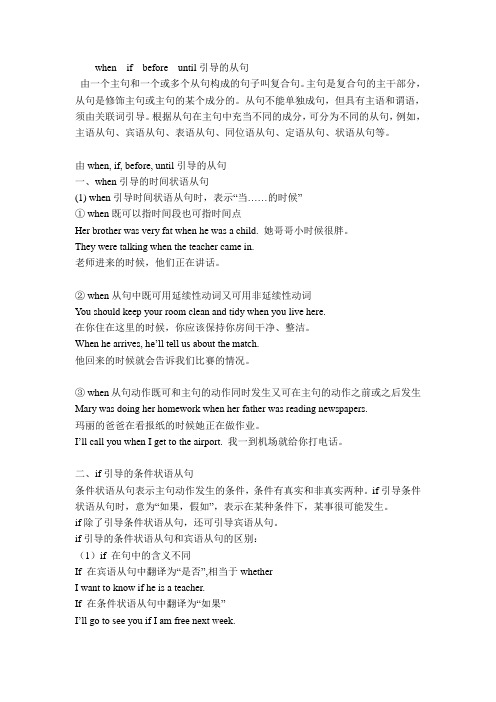
when if before until引导的从句
由一个主句和一个或多个从句构成的句子叫复合句。主句是复合句的主干部分,从句是修饰主句或主句的某个成分的。从句不能单独成句,但具有主语和谓语,须由关联词引导。根据从句在主句中充当不同的成分,可分为不同的从句,例如,主语从句、宾语从句、表语从句、同位语从句、定语从句、状语从句等。
由when, if, before, until引导的从句
一、when引导的时间状语从句
(1) when引导时间状语从句时,表示“当……的时候”
① when既可以指时间段也可指时间点
Her brother was very fat when he was a child. 她哥哥小时候很胖。
They were talking when the teacher came in.
老师进来的时候,他们正在讲话。
② when从句中既可用延续性动词又可用非延续性动词
You should keep your room clean and tidy when you live here.
在你住在这里的时候,你应该保持你房间干净、整洁。
When he arrives, he’ll tell us about the match.
他回来的时候就会告诉我们比赛的情况。
③ when从句动作既可和主句的动作同时发生又可在主句的动作之前或之后发生Mary was doing her homework when her father was reading newspapers.
玛丽的爸爸在看报纸的时候她正在做作业。
初中时间状语从句语法及练习教案资
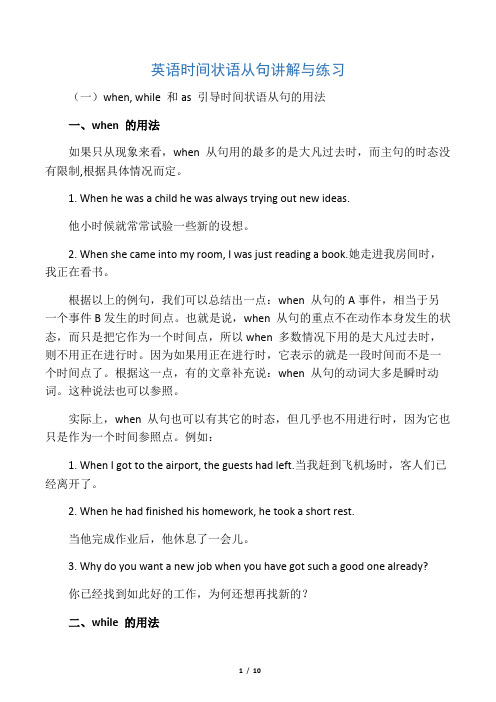
英语时间状语从句讲解与练习
(一)when, while 和as 引导时间状语从句的用法
一、when 的用法
如果只从现象来看,when 从句用的最多的是大凡过去时,而主句的时态没有限制,根据具体情况而定。
1. When he was a child he was always trying out new ideas.
他小时候就常常试验一些新的设想。
2. When she came into my room, I was just reading a book.她走进我房间时,我正在看书。
根据以上的例句,我们可以总结出一点:when 从句的A事件,相当于另一个事件B发生的时间点。也就是说,when 从句的重点不在动作本身发生的状态,而只是把它作为一个时间点,所以when 多数情况下用的是大凡过去时,则不用正在进行时。因为如果用正在进行时,它表示的就是一段时间而不是一个时间点了。根据这一点,有的文章补充说:when 从句的动词大多是瞬时动词。这种说法也可以参照。
实际上,when 从句也可以有其它的时态,但几乎也不用进行时,因为它也只是作为一个时间参照点。例如:
1. When I got to the airport, the guests had left.当我赶到飞机场时,客人们已经离开了。
2. When he had finished his homework, he took a short rest.
当他完成作业后,他休息了一会儿。
3. Why do you want a new job when you have got such a good one already?
by和before的区别

not until 的用法,与by,before的区别
一、until与by的区别
1. by表示在某特定的时间之前或不迟于某特定的时间,意为"最迟在;不迟于"或"在……之前"等。如:
①I will finish my task by nine.我将在九点钟前完成任务。
②The plane takes off at 10:00, so you must try to be at the airport by 9:30.飞机在十点钟起飞,所以你必须在九点半赶到机场。
2. until用在肯定句,谓语动词通常是延续性动词,如stand, stay, talk, wait等,表示主句动作终止的时间。如:
③I waited until he came back.我一直等到他回来。
④The war lasted until 1945.战争持续到1945年。
如果用在否定句,谓语动词通常是瞬间性动词,如open, start, leave, arrive, finish, stop等,强调主句动作开始的时间。如:
⑤I didn't leave the boy until his mother turned up.直到这孩子的母亲来,我才离开。
⑥The noise of the street didn't stop until it was midnight.街上的噪音直到半夜才停止。
二、until与before的区别
1.可直接换用的情况:在until能使用的句型中,即主句含有否定式终止性谓语动词或肯定式延续性动词,可与before直接替换,意义差别不大。如:
微课unti用法解读l解答

高考拾萃
I won't believe you____ I have seen it with my own eyes. A. although B. when C. until D.till
I will wait for you ____ you come back. until与till的区别 A. because B. till C. until D. if
介词(prep.)
He词w性连i词ll:(bceonwj)orking until 5 o'clock.
他将一直工作到五点钟。
(prep)
He ran until he was breathless.
他一直跑到气喘吁吁才停下。(conj)
基本用法
肯定句(延续性动词)+until+名词或句子。
直到下周才开运动会。
直到
特殊用法二
结构:Not until ...+助动词+主语+谓语+...
(当Not until位于句首时,句子才倒装。)
例句:
did stop Not until the teacher came in
the students
talking.
老师进来学生们才停止讲话。
在我爸爸回来前,我不会离开这儿.
高中时间状语从句和练习[含答案解析]
![高中时间状语从句和练习[含答案解析]](https://img.taocdn.com/s3/m/ebd3a8f8d05abe23482fb4daa58da0116c171f22.png)
高中时间状语从句和练习[含答案解析]
状语从句
状语从句在句中作状语,修饰主句中的动词、形容词或副词等。状语从句放在主句之前时,常用逗号分开;放在主句之后,一般不用逗号。状语从句按其意义和作用可分为时间、原因、地点、条件、让步、目的、结果、方式、比较等9种。
1.时间状语从句
时间状语从句表示主句动作发生的时间,主要由when,while,as ; before, after; till (until); once, by the time, as soon as, no sooner ... than和hardly ... when及名词词组the moment等引导。
1) when“在……的时候”; while “在……期间”; as “正当……的时候”
when意为“在……的时候”,强调“特定时间”。
When spring came, he felt like a trip.
When he was eating his breakfast, he heard the doorbell ring.
说明:连词when在状语从句中还有如下几种含义:
①表示突然发生的事,含义为“(正在……时)忽然”。
I was just coming along to see you when I ran into Wilson.
I had been working a couple of months when I had a letter from Jane.
②表示过早发生某事,意为“(还没……)就”。此含义有时可用before代替。
初中时间状语从句语法及练习
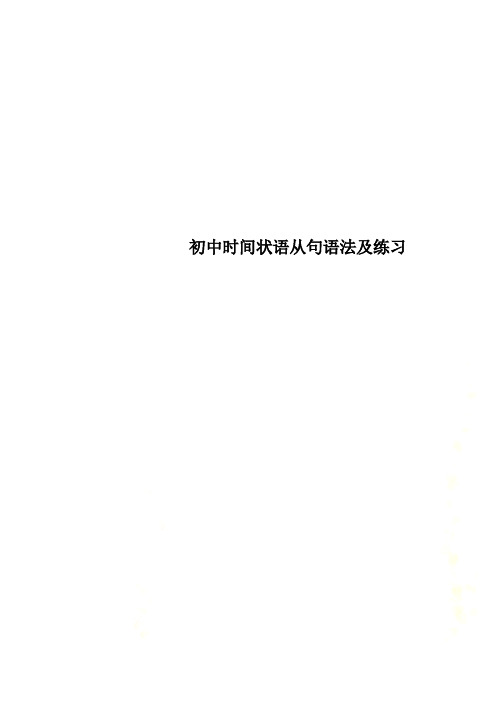
初中时间状语从句语法及练习
英语时间状语从句讲解与练习
(一)when, while 和as 引导时间状语从句的用法
一、when 的用法
如果只从现象来看,when 从句用的最多的是一般过去时,而主句的时态没有限制,根据具体情况而定。
1. When he was a child he was always trying out new ideas.
他小时候就常常试验一些新的设想。
2. When she came into my room, I was just reading a book. 她走进我房间时,我正在看书。
3. Were you writing when the teacher came in? 老师进来的时候,你在写信吗?
4. Sorry, I was out when you called me. 对不起,你打电话来的时候我出去了。
5. He was on the point of leaving when someone knocked at the door.
他正要走,这时有人敲门。
6. I thought of it just when you opened your mouth. 就在你要说话的时候,我也想到了。
7. I had hardly[scarcely] closed my eyes when someone knocked at the door.
我刚一闭上眼,就有人在敲门了。
根据以上的例句,我们可以总结出一点:when 从句的A事件,相当于另一个事件B发生的时间点。也就是说,when 从句的重点不在动作本身发生的状态,而只是把它作为一个时间点,所以when 多数情况下用的是一般过去时,则不用正在进行时。因为如果用正在进行时,它表示的就是一段时间而不是一个时间点了。根据这一点,有的文章补充说:when 从句的动词大多是瞬时动词。这种说法也可以参照。
初中英语介词总结

初中英语介词总结
介词
考点1、表示时间的介词
表示时间的介词有at, in, after, until, before, during.
1.at多用于表示具体的钟点时刻前,如:at seven, at a quarter to one; 也用于固定搭配中,如:at noon,
at night。
2.in 表示一段时间,用于年、月、世纪、四季或泛指的一天的上午、下午、晚上等。如:in the twenty-five
century 在21世纪,in autumn 在秋天,in the morning 在早上;还可用于表示“从现在起,多长时间以后或多久之后”
3.on 主要用在星期几,具体某一天或某一天的早、中、晚或节日前。如:
on Mid-autumn day 在中秋节on June 1st在6月1日
4.since,from和for
(1) since指从某时一直延续至今,后接时间点,只要用完成时。如:
He has lived here since 1993. 从1993年开始他一直住这里。
(2)from说明开始的时间,谓语可用过去、现在、将来的某种失态。如:
From now on, I will learn English in the morning. 从今以后,我将在早晨学英语。
(3)for指动作延续贯穿整个过程,后接时间段,主句用完成时。如:
I have studied English for six years. 我已经学英语六年了。
5. (1)after表示以过去为起点的某一段时间之后,用于过去时。如:
PPT课件 until
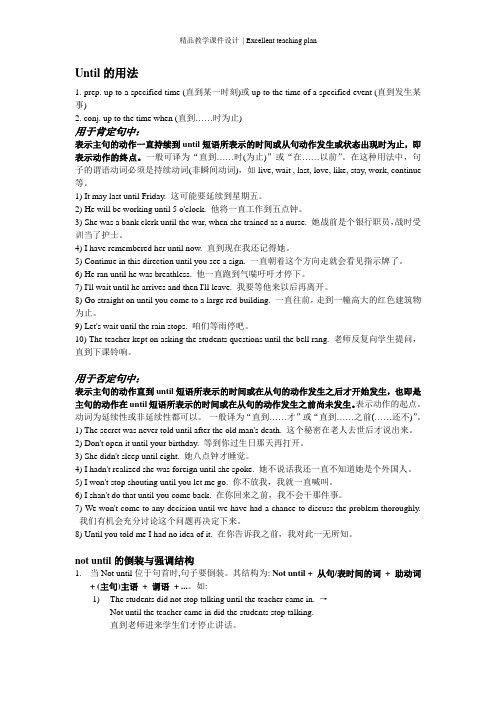
Until的用法
1. prep. up to a specified time (直到某一时刻)或up to the time of a specified event (直到发生某事)
2. conj. up to the time when (直到……时为止)
用于肯定句中:
表示主句的动作一直持续到until短语所表示的时间或从句动作发生或状态出现时为止,即表示动作的终点。一般可译为“直到……时(为止)”或“在……以前”。在这种用法中,句子的谓语动词必须是持续动词(非瞬间动词),如live, wait , last, love, like, stay, work, continue 等。
1) It may last until Friday. 这可能要延续到星期五。
2) He will be working until 5 o'clock. 他将一直工作到五点钟。
3) She was a bank clerk until the war, when she trained as a nurse. 她战前是个银行职员,战时受训当了护士。
4) I have remembered her until now. 直到现在我还记得她。
5) Continue in this direction until you see a sign. 一直朝着这个方向走就会看见指示牌了。
6) He ran until he was breathless. 他一直跑到气喘吁吁才停下。
7) I'll wait until he arrives and then I'll leave. 我要等他来以后再离开。
in after later before ago earlier until 状语 区别

时间状语小结- 前前后后
In
【in + 时间段】介词,后接时间段,不能与时间点连用。In用来表示从现在算起的“过一段时间以后”,常用在将来时的肯定句里,一般与go, come, start, arrive, return (be back), finish等表示瞬间动作动词连用,通常用于将来时或含有将来意义的句子。
They will arrive in half an hour. 半小时后他们将到达。
He will leave in a minute. 他一会儿就走。
After介词其后既可接时间点,又可接时间段。
【after+时间段】表示以过去时间为起点的一段时间以后,因此通常与过去时连用;
He left there after two o'clock that afternoon.那天下午两点以后,他离开了那儿。
He started to go again after two days.两天以后,他又走了。
【after+时间点】如果用于一般将来时,那么其后应接时间点。
He'll come here after three o'clock.他3点钟后将来这儿。
He will arrive after five o’clock. 他5 点钟以后到。
【after+句子】连词,其后可接从句,连接2个句子。
I'll call you after I've spoken to them. 我和他们谈了以后就给你打电话。
After she had mixed flour with water, the children came home. 她用水和好面之后,孩子们回来了。
常用介词用法及区别整理

1、表示时间的介词
(1)at:用于表示时刻,时间的某一点,年龄,就餐时间
at noon在午时at night在夜间at present目前
(2)on:用于星期几,某天,某一天的上午、下午、晚上(指具体的某一天时,一律用,也可以说是上午、下午、晚上有修饰的一律用ON),特定的时间、含day的节日
on Sunday 在星期天
on Sunday morning 在星期天的上午
on March 8 在3月8日
(3)in:用于表示周、月、季节、年、泛指上午、下午、晚上。
in 1999 在1999年in November 在11月份
in summer 在夏季in the afternoon在下午
in + 时间段:过……后(内),用于将来时
I think he will be back in an hour.
我想他一小时后就会回来。
I heard that she would be back in a month.我听说她一个月后回来的。
(4)after:在……之后
after that ,no one should ever kill a seagull .
从那时起,任何人不得捕杀海鸥。
after + 时间段:在……之后,用于过去时。
(5)before:在……之前
Wei hua got up before 7 o’clock this morning .
今天早晨,魏华在7点之前起床了。
He won’t come back before five.
(6)by:到……为止,截止(到)……
By the time i arrived ,she had already gone .
初中介词(表时间地点介词)讲解练习及答案

初中介词(表时间地点介词)讲解练习及答案
介词(表时间地点)
一、知识回顾
介词为虚词,不能单独充当句子成分,必须同名词、代词、短语、句子构成介词短语,才能充当句子成分。介词短语在句中常作表语、定语、状语和补足语。
常用表式时间地点的介词介绍
(一)表示时间的介词:
1.at, on, in
(1) at表示“在某一时刻、某一时间点”
at 5:30在5:30at sunrise 日出时at lunch 午饭时
at noon正午时at night 夜间
I get up at 6:00 every day. 我每天6:00起床。
表示“在……岁”时用at the age of…。
如:at the age of five 在五岁时
(2) on表示“在具体某一天或某天的上、下午”。如:
on Monday在星期一on April 1st在四月一日
I heard a shot on the morning of March 18.三月十八日早晨我听到一声枪响。
泛指上、下午、晚上、夜间时用in the morning/afternoon/evening, at night;但若指具体某一天的上述时段时,则一律用on。
如:on the afternoon of May 23 在五月二十三日下午
(3) in表示“在某月、季节、年、世纪”以及泛指的上、下午、晚上。
in September在九月in winter在冬季
in 1999 在1999年in the 20th century在20世纪
in the morning/afternoon/evening 在上午/下午/晚上
since等的辨析
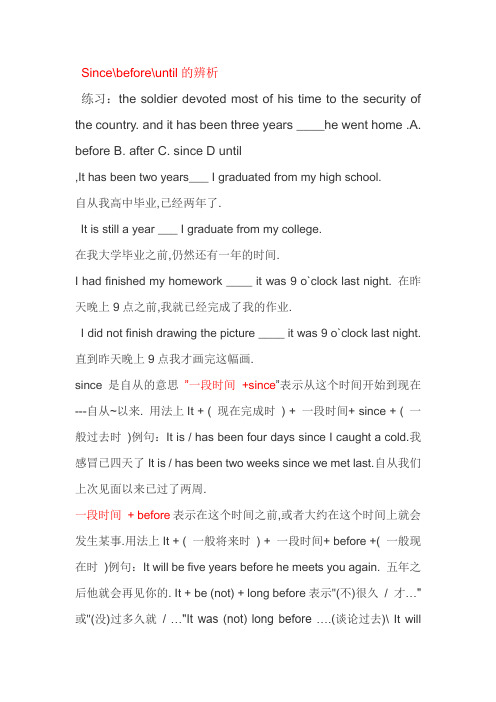
Since\before\until的辨析
练习:the soldier devoted most of his time to the security of the country. and it has been three years ____he went home .A. before B. after C. since D until
,It has been two years___ I graduated from my high school.
自从我高中毕业,已经两年了.
It is still a year ___ I graduate from my college.
在我大学毕业之前,仍然还有一年的时间.
I had finished my homework ____ it was 9 o`clock last night. 在昨天晚上9点之前,我就已经完成了我的作业.
I did not finish drawing the picture ____ it was 9 o`clock last night. 直到昨天晚上9点我才画完这幅画.
since是自从的意思”一段时间+since”表示从这个时间开始到现在---自从~以来. 用法上It + ( 现在完成时) + 一段时间+ since + ( 一般过去时)例句:It is / has been four days since I caught a cold.我感冒已四天了It is / has been two weeks since we met last.自从我们上次见面以来已过了两周.
before until since when之间的区别
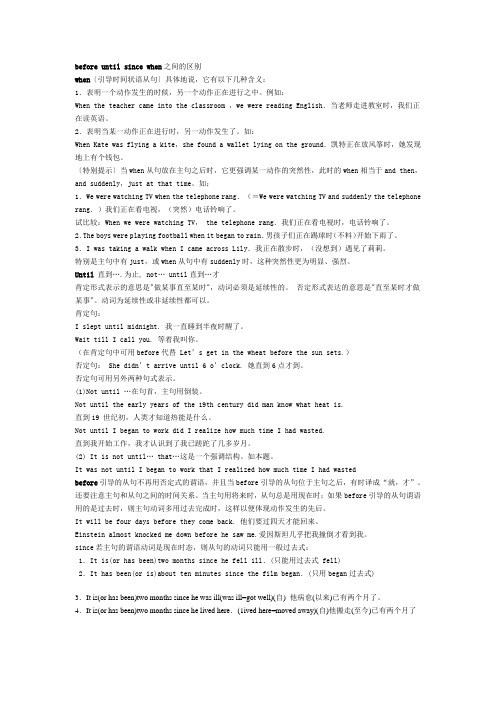
before until since when之间的区别
when〔引导时间状语从句〕具体地说,它有以下几种含义:
1.表明一个动作发生的时候,另一个动作正在进行之中。例如:
When the teacher came into the classroom ,we were reading English.当老师走进教室时,我们正在读英语。
2.表明当某一动作正在进行时,另一动作发生了。如:
When Kate was flying a kite,she found a wallet lying on the ground.凯特正在放风筝时,她发现地上有个钱包。
〔特别提示〕当when从句放在主句之后时,它更强调某一动作的突然性,此时的when相当于and then,and suddenly,just at that time。如;
1.We were watching TV when the telephone rang.(=We were watching TV and suddenly the telephone rang.)我们正在看电视,(突然)电话铃响了。
试比较:When we were watching TV, the telephone rang.我们正在看电视时,电话铃响了。
2.The boys were playing football when it began to rain.男孩子们正在踢球时(不料)开始下雨了。3.I was taking a walk when I came across Lily.我正在散步时,(没想到)遇见了莉莉。
Until的详细用法总结
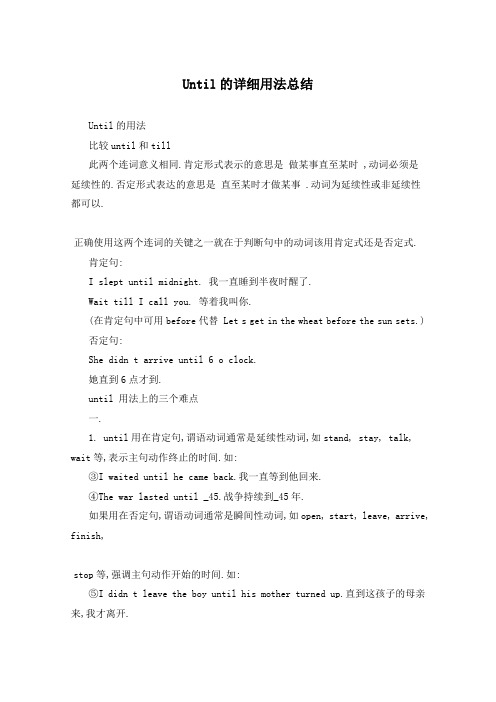
Until的详细用法总结
Until的用法
比较until和till
此两个连词意义相同.肯定形式表示的意思是做某事直至某时 ,动词必须是
延续性的.否定形式表达的意思是直至某时才做某事 .动词为延续性或非延续性
都可以.
正确使用这两个连词的关键之一就在于判断句中的动词该用肯定式还是否定式.
肯定句:
I slept until midnight. 我一直睡到半夜时醒了.
Wait till I call you. 等着我叫你.
(在肯定句中可用before代替 Let s get in the wheat before the sun sets.) 否定句:
She didn t arrive until 6 o clock.
她直到6点才到.
until 用法上的三个难点
一.
1. until用在肯定句,谓语动词通常是延续性动词,如stand, stay, talk, wait等,表示主句动作终止的时间.如:
③I waited until he came back.我一直等到他回来.
④The war lasted until _45.战争持续到_45年.
如果用在否定句,谓语动词通常是瞬间性动词,如open, start, leave, arrive, finish,
stop等,强调主句动作开始的时间.如:
⑤I didn t leave the boy until his mother turned up.直到这孩子的母亲来,我才离开.
⑥The noise of the street d idn t stop until it was
By,before,until三个介词的用法区别
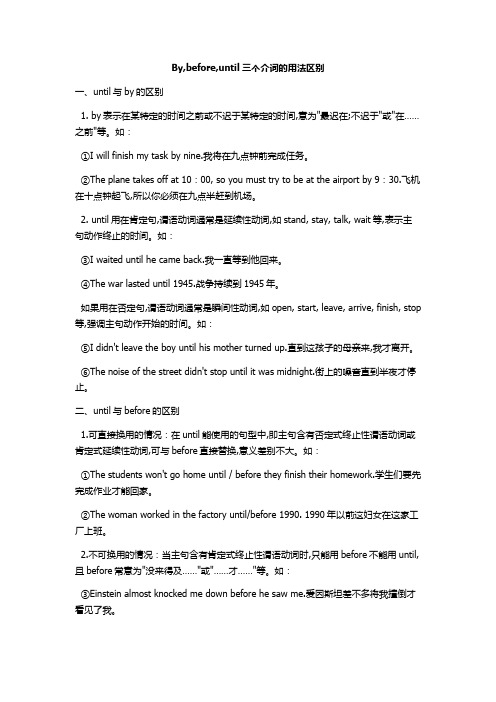
By,before,until三个介词的用法区别
一、until与by的区别
1. by表示在某特定的时间之前或不迟于某特定的时间,意为"最迟在;不迟于"或"在……之前"等。如:
①I will finish my task by nine.我将在九点钟前完成任务。
②The plane takes off at 10:00, so you must try to be at the airport by 9:30.飞机在十点钟起飞,所以你必须在九点半赶到机场。
2. until用在肯定句,谓语动词通常是延续性动词,如stand, stay, talk, wait等,表示主句动作终止的时间。如:
③I waited until he came back.我一直等到他回来。
④The war lasted until 1945.战争持续到1945年。
如果用在否定句,谓语动词通常是瞬间性动词,如open, start, leave, arrive, finish, stop 等,强调主句动作开始的时间。如:
⑤I didn't leave the boy until his mother turned up.直到这孩子的母亲来,我才离开。
⑥The noise of the street didn't stop until it was midnight.街上的噪音直到半夜才停止。
二、until与before的区别
1.可直接换用的情况:在until能使用的句型中,即主句含有否定式终止性谓语动词或肯定式延续性动词,可与before直接替换,意义差别不大。如:
By,before,until三个介词的用法区别

By,before,until三个介词的用法区别
一、until与by的区别
1. by表示在某特定的时间之前或不迟于某特定的时间,意为"最迟在;不迟于"或"在……之前"等。如:
①I will finish my task by nine.我将在九点钟前完成任务。
②The plane takes off at 10:00, so you must try to be at the airport by 9:30.飞机在十点钟起飞,所以你必须在九点半赶到机场。
2. until用在肯定句,谓语动词通常是延续性动词,如stand, stay, talk, wait等,表示主句动作终止的时间。如:
③I waited until he came back.我一直等到他回来。
④The war lasted until 1945.战争持续到1945年。
如果用在否定句,谓语动词通常是瞬间性动词,如open, start, leave, arrive, finish, stop 等,强调主句动作开始的时间。如:
⑤I didn't leave the boy until his mother turned up.直到这孩子的母亲来,我才离开。
⑥The noise of the street didn't stop until it was midnight.街上的噪音直到半夜才停止。
二、until与before的区别
1.可直接换用的情况:在until能使用的句型中,即主句含有否定式终止性谓语动词或肯定式延续性动词,可与before直接替换,意义差别不大。如:
- 1、下载文档前请自行甄别文档内容的完整性,平台不提供额外的编辑、内容补充、找答案等附加服务。
- 2、"仅部分预览"的文档,不可在线预览部分如存在完整性等问题,可反馈申请退款(可完整预览的文档不适用该条件!)。
- 3、如文档侵犯您的权益,请联系客服反馈,我们会尽快为您处理(人工客服工作时间:9:00-18:30)。
浅析before和until的区别
在日常的英语学习中,我们遇到before和until时,往往会将二者搞错。其实,只要我们能把握住两者在使用时本身的含义及主句动词是终止性的还是延续性的,是肯定式还是否定式两大特点,就能很容易地解决这类问题。
一、在下列情况下,两者可互换用,但含义略有不同。before表示“在……之前”的意思,强调时间先后关系;而until表示“直到……才”的意思,主句是肯定句则表示主句动作的终止时间;主句是否定句则强调主句动作的起始时间。
1.主句为否定式终止性谓语动词。常见的动词是open, start, leave, arrive, finish, stop等。例如:
(1)The noise of the street didn’t stop until/before it was midnight.
(2)The children won’t come back until/before it is dark.
(3)I didn’t leave the lovely boy until/before his mother came home.
2.主句为肯定式、延续性谓语词,这类动词用stand, stay, talk, be, wait等。例如:
(1)He lived with his parents until/before he graduated from school.
(2)I will wait until/before he comes to my help.
(3)I shall stay here until/before you come back.
二、下列情况下宜用before不用until.
1.主句为肯定式,谓语为瞬间动词时只用before. (想一想为什么)1) He fell asleep before I could take off his clothes.
2) We arrived there before it started to rain.
3) The holiday came to an end before I knew it.
4) He almost knocked me down before he saw me.
2.主句谓语动词强调动作的迟缓性,只用before,这时常伴有时间段状语或时间段暗示。
It was quite a long time before he found the elephant.过了很长时间,他才找到大象。
We had walked a long way before we found some water.走了很长的路我们才找到水。
We had sailed for two days before we saw the land.航行了两天我们才发现陆地。
It was midnight before my brother came home.我哥哥直到半夜才回来。
3.如果强调从句谓语动作未发生就发生主句谓语动作,只用before,这时常译为“未及(不等)……就……”
1)We can leave early in the morning before it gets too hot.趁天还不太热,我们上午早点离开。
2)I must write it down before I forget it.趁我还未忘,我必须把它记下来。
4.表示“与其说……倒不如……”,“与其……毋宁……”的意思时只用before.
I would give up my job before I agree to be dismissed. 我与其被解雇还不如先辞职。
He will die of hunger before he steals.他宁愿饿死也不愿意去偷。
5.在某些特定句型中用before。
It was (not) long before…(不久)过了很长时间才…
It will (not) be long before…(不到)要过很长时间才会… For example:
It will probably not be long before they understand each other. 他们大概过不久就会互相了解。
It was not long before the whole country rose up. 不久全国人民奋起反抗。
long before很早以前
三、下列情况一般使用until
1.主句是持续性谓语动词时,肯定,否定都可以,但意义完全不同,肯定表示动作终止,而否定表示动作开始。For example:
1)We discussed the problem until/before he came back. 我们一直讨论到他回来。
2)We didn’t discuss the problem until he came back. 我们一直等他回来才讨论问题。(持续动词之否定)
2.Not…until…句型尽管在某些情况下可与before互换使用,但在强调句中一般仍用until;
1). It was not until he told me that I knew it.直到他告诉我我才知道这件事。
2)It was not until he finished his homework that he went home.直到完成作业他才回家。
3.放于句首时用until.
Until he finished his homework he didn’t go home. 直到完成作业他才回家。
应注意:在使用not until时,若not until放于句首,句子应部分倒装。
Not until he finished his homework did he go home. 直到完成作业他才回家。
四、其他技巧
1.before只是陈述以前的事实,用until则着重后来的变化情况:
